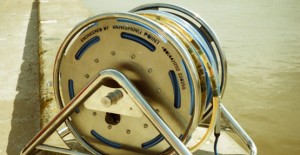Hydrophones
Passive acoustic hydrophones are highly sensitive underwater microphones. Using such a system it is possible to detect the vocalisations of many species of marine mammal.
 Developed and tested for reliability, VPMarine offers you a range of equipment, for purchase or rental, from simple hydrophones deployed from a small boat, to full scientific monitoring and reporting facilities for the offshore oil, gas and demolition industries. The more complex monitoring arrays are rented on a daily basis along with an operator or a full team depending on requirements.
Developed and tested for reliability, VPMarine offers you a range of equipment, for purchase or rental, from simple hydrophones deployed from a small boat, to full scientific monitoring and reporting facilities for the offshore oil, gas and demolition industries. The more complex monitoring arrays are rented on a daily basis along with an operator or a full team depending on requirements.
Our complete package also offers real-time monitoring, using the latest automatic detection software, and the ability to digitally record marine mammal vocalisations and ambient noise. Vanishing Point is always happy to discuss a system to suit your project needs.
Vanishing Point Standard Acoustic Monitoring System |
||||
Towed Hydrophone |
||||
| Acoustic Channels | 2 x Low to Medium FrequencyBenthos AQ4. –201 dBV re 1mPa (+/- 1.5 dB 1-15kHz)with Magrec HP02 broad band preamps (LF cut – 3dB @ 100Hz)
Nominal Sensitivity 75Hz- 25kHz |
|||
| 2 x High Frequency Magrec HP03, comprising a spherical ceramic and HP02 preamp (Low cut filter set at 2kHz)Nominal sensitivity 1.5kHz- 150kHz | ||||
| Depth Sensor | Keller 4-20Ma 100m rangeAutomatically read and displayed within PAMUARD | |||
| Streamlined housing | 5m, 3 cm diameter polyurethane tube. Filled with Isopar M hydrophone oil. | |||
| Cable | 340m multiple screened twisted pair, with strain relief and Kellum’s grip towing eye,Length may vary to suit application | |||
| Connectors | 19 pin Ceep IP68 waterproof | |||
| Deck Cable | ~75m 19pin Ceep to breakout box | |||
| Topside Amplifier Filter Unit | Magrec HP/27ST | |||
| Supply Voltage | 10-35 V DC | |||
| Supply current | 200mA at 12 V | |||
| Input | Balanced input | |||
| Gain | 0,10,20,30,40,50 dB | |||
| High Pass Filter | -6db/octave selectable 0, 40, 80, 400,1.6k, 3.2k | |||
| Output | 2 X Balanced output via 3 pin XLR | |||
| Tans output | 2 X Balanced output via 3 pin XLR (with 20kHz high pass filter for porpoise detection) | |||
| Headphone | Dual output via ¼” jack | |||
| Overall Bandwidth | 10Hz-200kHz +/–3dB | |||
| GPS | Serial to USB adapter to interface with ship’s NMEA supply | |||
| Standalone USB unit as independent backup | ||||
Computer |
Up to date Laptop Computer | |||
Digitisers |
NI USB broad band digitiser (if required for porpoise detection) | |||
| Konnekt 24D 192kHz firewire digitiser with inbuilt digital filtering | ||||
| Or Fireface 400 firewire digitiser / MOTU Mk111 | ||||
Software |
General | PAMGUARD with appropriate configurations | ||
| Porpoise Detection | Rainbow Click/ Logger | |||
Testing and Quality Control
- Between jobs used hydrophones are taken off their reels and inspected for damage.
- Complete systems are assembled and checked for noise or interference. We are testing a gel contact calibration sound source to allow a quantitative assessment of sensitivity across the full frequency range for each element. The operation of the depth sensor is tested.
- Field computers are cleaned of old data files, all software is updated and optimisation software is run.
To meet the needs of industry, VPMarine is currently working to develop new and improved systems using either remote tethered pods, transmitting data by radio signal, or deployment from ship-based remotely operated vehicles (ROV’s). In addition to passive detection, there is growing evidence to support the use of active deterrents for environmental protection. These units are designed to emit sounds that deter, but are not harmful, to the target species to protect them from industrial activities. Vanishing Point aims to design deterrents that are applicable to a wide range of species.In the past years VPMarine has delivered acoustic systems for use by National Oceanic Atmospheric Administration (NOAA) USA, QinetiQ (formerly DERA), Conoco UK, and Gardline UK in addition to many academic marine research teams around the world.
